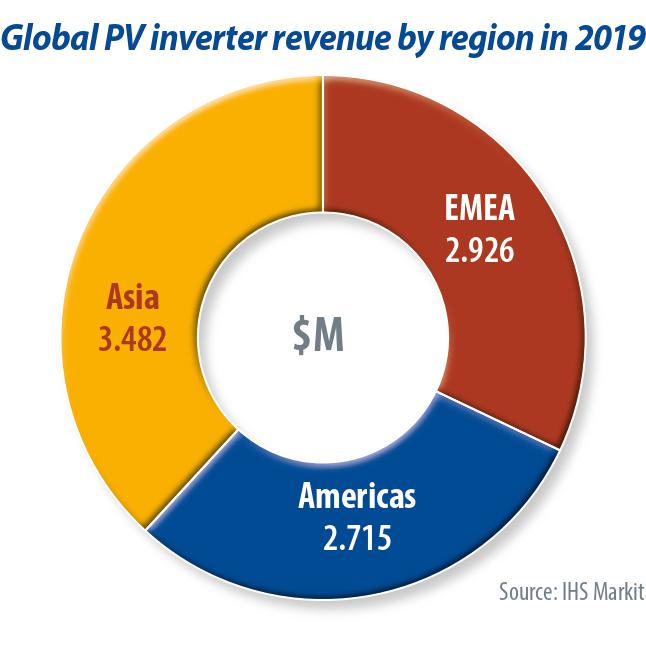The global competitive landscape for inverters remains relatively consolidated. The top 10 suppliers accounted for more than 70% of global PV inverter shipments. As the industry continues to enjoy rapid growth, competition is expected to escalate among PV inverter suppliers due to two key factors: advancements in technology and the shifting balance of global installation growth.
Pushing the limits
Several key technology trends offer opportunities for PV inverter suppliers to compete more aggressively in a growing industry. For example, suppliers continue to release larger inverters, particularly three-phase string and central inverters for utility-scale solar PV installations. Over the last few years, three-phase string inverter suppliers have worked hard to educate customers on the merits of a distributed architecture for large-scale solar PV systems. Overall, these suppliers have succeeded, as the penetration rate of string inverters has steadily increased – especially in large commercial projects and small utility-scale installations. Recently, suppliers have released string inverters exceeding 200 kW as they begin to compete for larger system sizes and bid for highly price competitive projects.
The same trend is influencing central inverter manufacturers, with leading suppliers releasing larger average sizes. Shipments of larger standalone central inverters between 3 MW and 4 MW increased by 67% to reach 15.5 GW, accounting for more than one-third of global central inverter shipments in 2019. IHS Markit expects larger central inverter shipments to increase in the next five years, as central inverter suppliers aim to compete more aggressively on a cost-per-watt basis, while defending against the encroachment of larger string inverters in utility-scale installations.
As suppliers continue to push the limits of PV inverter power, they are turning to new materials and software that can help them make the next leap in technology. For example, suppliers are carefully monitoring silicon carbide prices, which hold the potential for inverter designers to build even more efficient and power-dense PV inverters. Meanwhile, suppliers across the entire balance of systems segment are waiting for cues on a shift toward even higher voltages, particularly in utility-scale installations where the standard has rapidly become 1500 V.
Cybersecurity and AI
Advanced software and grid features such as voltage control, frequency control and reactive power at night have become the prerequisite for inverter suppliers to be selected by system owners to futureproof their solar investments. Advanced software requirements include performing operation and component tests in real time, such as IV curve diagnostics. These are now increasingly commonplace and provided by leading suppliers such as Huawei and Sungrow.
As inverters are considered the brains of solar PV plants, advancements such as artificial intelligence and cybersecurity are taking center stage, because suppliers are trying to add increasing adaptability and protection to solar assets. PV inverter suppliers recognize that solar inverters will increasingly interact with the grid from residential level up to utility-scale systems. As a result, it will be incumbent on suppliers to implement the highest levels of cybersecurity to ensure that utilities and homeowners are protected to the highest standards against any malicious attacks to their energy systems.
Residential inverters
The residential PV inverter market was the fastest-growing system type, increasing more than 50% in 2019. Solar inverter suppliers offering single-phase and three-phase <10kW inverters in their portfolios in 2019 were able to take advantage of this market opportunity. Leading module-level power electronics (MLPE) suppliers such as SolarEdge and Enphase – as well as single-phase suppliers such as SMA, Growatt and Ginlong – increased shipments to this segment. Key residential markets such as China, United States, the Netherlands, Japan, and Australia were instrumental in aiding the growth of global residential installations. PV inverter suppliers continued to innovate in this segment with aesthetically designed products built to be lighter, smaller, more power-dense, and with new safety features.
Chinese suppliers
PV inverter demand decreased for the second year in a row in China in 2019 due to declining installations. Although China remains the largest solar market in the world, Chinese suppliers – which had previously enjoyed huge growth by supplying their domestic market – have set their sights on international markets to help limit the impact of a smaller domestic market and to offset any revenue losses due to continued price pressure. China-based suppliers increased their international market share by seven percentage points to 38% in 2019.
In particular, they have quickly expanded their presence across Europe, India, Southeast Asia, and Latin America. Chinese suppliers continue to make significant investments to rapidly update their products to meet local grid and technical requirements and set up local sales and service offices. To help fuel this expansion, some Chinese suppliers, such as Ginlong and Sineng, have turned to investors by issuing shares in initial public offerings. The result is an increase in the diversity of the competitive landscape in these regions. Strong growth in new installations in several major solar markets have benefited all suppliers, including key incumbent suppliers such as SMA, which has maintained a longstanding foothold in its home market in Germany and across Europe. Another example is Power Electronics, based in Spain, which maintains the leading position in its home market while also achieving a dominant position in capturing booming growth in utility-scale shipments in the United States.
Overall, a more diverse group of PV inverter suppliers will be competing against each other in markets all over the world and across all system types, from residential to commercial to utility-scale installations. In the short term, strong price pressure will help some suppliers defend or increase their market share. Long term, the industry may potentially see further consolidation, either as suppliers win out and acquire even greater market shares, or as suppliers merge or are acquired to build complementary product portfolios.






